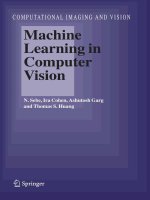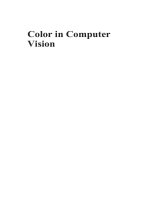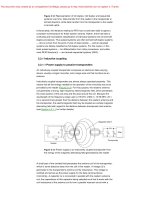gevers, gijsenij, weijer, geusebroek - color in computer vision. fundamentals and application
Bạn đang xem bản rút gọn của tài liệu. Xem và tải ngay bản đầy đủ của tài liệu tại đây (6.42 MB, 375 trang )
Color in Computer
VisionColor in Computer
Vision
Fundamentals and Applications
Theo Gevers
Intelligent Systems Lab. Amsterdam,
University of Amsterdam (The Netherlands)
and
Computer Vision Center,
Universitat Aut
`
onoma de Barcelona (Spain)
Arjan Gijsenij
Intelligent Systems Lab. Amsterdam,
University of Amsterdam (The Netherlands)
Joost van de Weijer
Computer Vision Center,
Universitat Auton
`
oma de Barcelona (Spain)
Jan-Mark Geusebroek
Intelligent Systems Lab. Amsterdam,
University of Amsterdam (The Netherlands)
A John Wiley & Sons, Inc., Publication
Cover image: Jasper van Turnhout
Cover design: Michael Rutkowski
Copyright © 2012 by John Wiley & Sons, Inc. All rights reserved
Published by John Wiley & Sons, Inc., Hoboken, New Jersey
Published simultaneously in Canada
No part of this publication may be reproduced, stored in a retrieval system, or transmitted
in any form or by any means, electronic, mechanical, photocopying, recording, scanning,
or otherwise, except as permitted under Section 107 or 108 of the 1976 United States
Copyright Act, without either the prior written permission of the Publisher, or
authorization through payment of the appropriate per-copy fee to the Copyright Clearance
Center, Inc., 222 Rosewood Drive, Danvers, MA 01923, (978) 750-8400, fax (978)
750-4470, or on the web at www.copyright.com. Requests to the Publisher for permission
should be addressed to the Permissions Department, John Wiley & Sons, Inc., 111 River
Street, Hoboken, NJ 07030, (201) 748-6011, fax (201) 748-6008, or online at
/>Limit of Liability/Disclaimer of Warranty: While the publisher and author have used their
best efforts in preparing this book, they make no representations or warranties with
respect to the accuracy or completeness of the contents of this book and specifically
disclaim any implied warranties of merchantability or fitness for a particular purpose. No
warranty may be created or extended by sales representatives or written sales materials.
The advice and strategies contained herein may not be suitable for your situation. You
should consult with a professional where appropriate. Neither the publisher nor author
shall be liable for any loss of profit or any other commercial damages, including but not
limited to special, incidental, consequential, or other damages.
For general information on our other products and services or for technical support, please
contact our Customer Care Department within the United States at (800) 762-2974,
outside the United States at (317) 572-3993 or fax (317) 572-4002.
Wiley also publishes its books in a variety of electronic formats. Some content that
appears in print may not be available in electronic formats. For more information about
Wiley products, visit our web site at www.wiley.com.
Library of Congress Cataloging-in-Publication Data:
Color in computer vision : fundamentals and applications / Theo Gevers [et al.].
p. cm.
Includes bibliographical references and index.
ISBN 978-0-470-89084-4 (pbk.)
1. Computer vision. 2. Color vision. 3. Color photography. I. Gevers,
Theo.
TA1634.C637 2012
006.3
7—dc23
2012000650
Printed in the United States of America
ISBN: 9780470890844
10987654321
To my parents, Dick and Wil
—Theo Gevers
To my wife Petra
—Arjan Gijsenij
To Line
—Joost van de Weijer
To my wife Astrid and our daughters Nora and Ellen
—Jan-Mark Geusebroek
Contents
Preface xv
1 Introduction . 1
1.1 From Fundamental to Applied 2
1.2 Part I: Color Fundamentals 3
1.3 Part II: Photometric Invariance . 3
1.3.1 Invariance Based on Physical Properties. 4
1.3.2 Invariance By Machine Learning . . 4
1.4 Part III: Color Constancy . 4
1.5 Part IV: Color Feature Extraction . 5
1.5.1 From Luminance to Color 5
1.5.2 Features, Descriptors, and Saliency . 6
1.5.3 Segmentation . 6
1.6 PartV:Applications 7
1.6.1 Retrieval and Visual Exploration . 7
1.6.2 ColorNaming 7
1.6.3 Multispectral Applications . 8
1.7 Summary 9
PART I Color Fundamentals . . 11
2 ColorVision 13
2.1 Introduction . 13
2.2 Stages of Color Information Processing . 14
2.2.1 EyeandOptics 14
2.2.2 Retina: Rods and Cones . 14
2.2.3 Ganglion Cells and Receptive Fields . 16
2.2.4 LGNandVisualCortex 16
vii
Contents
2.3 Chromatic Properties of the Visual System . . . . 18
2.3.1 Chromatic Adaptation . 18
2.3.2 Human Color Constancy 18
2.3.3 SpatialInteractions 20
2.3.4 Chromatic Discrimination and Color Deficiency . 23
2.4 Summary 24
3 Color ImageFormation 26
3.1 Lambertian Reflection Model . 28
3.2 Dichromatic Reflection Model . . . 29
3.3 Kubelka–Munk Model . 32
3.4 The Diagonal Model . 34
3.5 Color Spaces . 36
3.5.1 XYZ System 36
3.5.2 RGBSystem 38
3.5.3 Opponent Color Spaces . 40
3.5.4 Perceptually Uniform Color Spaces . . . . 41
3.5.5 Intuitive Color Spaces . 42
3.6 Summary 44
PART II Photometric Invariance . 47
4 Pixel-Based Photometric Invariance . 49
4.1 Normalized Color Spaces . 50
4.2 Opponent Color Spaces 52
4.3 The HSV Color Space. 52
4.4 Composed Color Spaces. . 53
4.4.1 Body Reflectance Invariance . 53
4.4.2 Body and Surface Reflectance Invariance 55
4.5 Noise Stability and Histogram Construction . 58
4.5.1 Noise Propagation . 58
4.5.2 Examples of Noise Propagation through Transformed Colors . . . 60
4.5.3 Histogram Construction by Variable Kernel Density
Estimation 61
4.6 Application: Color-Based Object Recognition . 64
4.6.1 Dataset and Performance Measure . . . 64
4.6.2 Robustness Against Noise: Simulated Data . 65
4.7 Summary 68
5 Photometric Invariance from Color Ratios. 69
5.1 Illuminant Invariant Color Ratios . . . 71
5.2 Illuminant Invariant Edge Detection . 73
5.3 Blur-Robust and Color Constant Image Description . 74
viii
Contents
5.4 Application: Image Retrieval Based on Color Ratios 77
5.4.1 Robustness to Illuminant Color. . . . 77
5.4.2 Robustness to Gaussian Blur 78
5.4.3 Robustness to Real-World Blurring Effects . . 78
5.5 Summary 80
6 Derivative-Based Photometric Invariance 81
6.1 Full Photometric Invariants . 84
6.1.1 The Gaussian Color Model 84
6.1.2 The Gaussian Color Model by an RGB Camera . 88
6.1.3 Derivatives in the Gaussian Color Model. 89
6.1.4 Differential Invariants for the Lambertian Reflection Model . . . . 90
6.1.5 Differential Invariants for the Dichromatic Reflection
Model . . 95
6.1.6 Summary of Full Color Invariants . . . 98
6.1.7 Geometrical Color Invariants in Two Dimensions . 100
6.2 Quasi-Invariants . 101
6.2.1 Edges in the Dichromatic Reflection Model 101
6.2.2 Photometric Variants and Quasi-Invariants . 103
6.2.3 Relations of Quasi-Invariants with Full Invariants. 104
6.2.4 Localization and Discriminative Power of Full and
Quasi-Invariants . 108
6.3 Summary 111
7 Photometric Invariance by Machine Learning . 113
7.1 LearningfromDiversifiedEnsembles 114
7.2 TemporalEnsembleLearning 119
7.3 Learning Color Invariants for Region Detection 120
7.4 Experiments 124
7.4.1 ErrorMeasures 124
7.4.2 Skin Detection: Still Images 125
7.4.3 Road Detection in Video Sequences . 129
7.5 Summary 134
PARTIII Color Constancy 135
8 Illuminant Estimation and Chromatic Adaptation . . 137
8.1 Illuminant Estimation . 139
8.2 Chromatic Adaptation. 141
9 Color Constancy Using Low-level Features . . 143
9.1 General Gray-World . 143
9.2 Gray-Edge 146
ix
Contents
9.3 Physics-Based Methods . 150
9.4 Summary 151
10 Color Constancy Using Gamut-Based Methods . . 152
10.1 Gamut Mapping Using Derivative Structures . 155
10.1.1 Diagonal-Offset Model . . . . 155
10.1.2 Gamut Mapping of Linear Combinations of Pixel Values . . . . . 155
10.1.3 N-JetGamuts 157
10.2 Combination of Gamut Mapping Algorithms . 157
10.2.1 Combining Feasible Sets 159
10.2.2 CombiningAlgorithmOutputs 159
10.3 Summary 160
11 ColorConstancy Using Machine Learning 161
11.1 Probabilistic Approaches . 161
11.2 CombinationUsingOutputStatistics 162
11.3 CombinationUsingNaturalImageStatistics 163
11.3.1 SpatialImageStructures 164
11.3.2 AlgorithmSelection 165
11.4 Methods Using Semantic Information 167
11.4.1 Using Scene Categories . 167
11.4.2 Using High-Level Visual Information 169
11.5 Summary 171
12 Evaluation of Color Constancy Methods . . . 172
12.1 DataSets 172
12.1.1 Hyperspectral Data . . 173
12.1.2 RGBData 173
12.1.3 Summary 174
12.2 Performance Measures . . . 175
12.2.1 Mathematical Distances . 176
12.2.2 Perceptual Distances . 176
12.2.3 Color Constancy Distances . 177
12.2.4 Perceptual Analysis . . 178
12.3 Experiments . . . 180
12.3.1 Comparing Algorithm Performance 181
12.3.2 Evaluation 182
12.4 Summary 185
PARTIV Color Feature Extraction 187
13 ColorFeature Detection 189
13.1 TheColorTensor 191
13.1.1 Photometric Invariant Derivatives . 193
x
Contents
13.1.2 Invariance to Color Coordinate Transformations . 195
13.1.3 Robust Full Photometric Invariance 196
13.1.4 Color-Tensor-Based Features . 197
13.1.5 Experiment: Robust Feature Point Detection and
Extraction 204
13.2 Color Saliency . 205
13.2.1 Color Distinctiveness . 207
13.2.2 Physics-Based Decorrelation. . . . 208
13.2.3 Statistics of Color Images 211
13.2.4 Boosting Color Saliency . 212
13.2.5 Evaluation of Color Distinctiveness . 214
13.2.6 Repeatability . 215
13.2.7 Illustrations of Generality 218
13.3 Conclusions. 218
14 Color Feature Description. . . 221
14.1 GaussianDerivative-BasedDescriptors 225
14.2 DiscriminativePower 229
14.3 Level of Invariance . 235
14.4 InformationContent 236
14.4.1 Experimental Results 242
14.5 Summary 243
15 ColorImage Segmentation 244
15.1 Color Gabor Filtering 245
15.2 Invariant Gabor Filters Under Lambertian Reflection . 247
15.3 Color-Based Texture Segmentation. 247
15.4 Material Recognition Using Invariant Anisotropic Filtering . 249
15.4.1 MR8-NC Filterbank . 253
15.4.2 MR8-INC Filterbank. 254
15.4.3 MR8-LINC Filterbank . 255
15.4.4 MR8-SLINC Filterbank . . . . 255
15.4.5 Summary of Filterbank Properties . 256
15.5 Color Invariant Codebooks and Material-Specific Adaptation . 256
15.6 Experiments 258
15.6.1 Material Classification by Color Invariant Codebooks . 258
15.6.2 Color–Texture Segmentation of Material Images . . 260
15.6.3 Material Classification by Adaptive Color Invariant
Codebooks . 262
15.7 Image Segmentation by Delaunay Triangulation . . 263
15.7.1 Homogeneity Based on Photometric Color Invariance . . . 264
15.7.2 Homogeneity Based on a Similarity Predicate 265
15.7.3 Difference Measure . . . 265
15.7.4 Segmentation Results 267
15.8 Summary 268
xi
Contents
PARTV Applications 269
16 Object and Scene Recognition. . 271
16.1 Diagonal Model . 272
16.2 ColorSIFTDescriptors 273
16.3 Object and Scene Recognition . 276
16.3.1 Feature Extraction Pipelines . 276
16.3.2 Classification 277
16.3.3 Image Benchmark: PASCAL Visual Object
Classes Challenge 278
16.3.4 Video Benchmark: Mediamill Challenge . 279
16.3.5 EvaluationCriteria 279
16.4 Results 280
16.4.1 Image Benchmark: PASCAL VOC Challenge . 280
16.4.2 Video Benchmark: Mediamill Challenge . 282
16.4.3 Comparison 283
16.5 Summary 285
17 ColorNaming 287
17.1 BasicColorTerms 288
17.2 ColorNamesfromCalibratedData 291
17.2.1 Fuzzy Color Naming . 293
17.2.2 Chromatic Categories . 294
17.2.3 Achromatic Categories . 298
17.2.4 Fuzzy Sets Estimation . 300
17.3 ColorNamesfromUncalibratedData 304
17.3.1 ColorNameDataSets 306
17.3.2 LearningColorNames 307
17.3.3 Assigning Color Names in Test Images . 311
17.3.4 Flexibility Color Name Data Set 312
17.4 Experimental Results 313
17.5 Conclusions. 316
18 Segmentationof Multispectral Images 318
18.1 Reflection and Camera Models 319
18.1.1 Multispectral Imaging. 319
18.1.2 Camera and Image Formation Models 319
18.1.3 White Balancing. 320
18.2 Photometric Invariant Distance Measures . 321
18.2.1 Distance between Chromaticity Polar Angles . 321
18.2.2 Distance between Hue Polar Angles . . 322
18.2.3 Discussion 325
18.3 Error Propagation . . . 325
18.3.1 Propagation of Uncertainties due to Photon Noise 325
18.3.2 Propagation of Uncertainty . 326
xii
Contents
18.4 Photometric Invariant Region Detection by Clustering. . 328
18.4.1 Robust K-Means Clustering 328
18.4.2 Photometric Invariant Segmentation . 329
18.5 Experiments 330
18.5.1 Propagation of Uncertainties in Transformed Spectra. . 331
18.5.2 Photometric Invariant Clustering . 334
18.6 Summary 338
Citation Guidelines 339
References 341
Index 363
xiii
Preface
Visual information is our most natural source of information and communication.
Apart from human vision, visual information plays a vital and indispensable role
in society and is the nucleus of current communication frameworks such as the
World Wide Web and mobile phones. With the ever-growing production, use,
and exploitation of digital visual information (e.g., documents, websites, images,
videos, and movies), a visual overflow will occur, and hence demands are urgent
for the (automatic) understanding of visual information. Moreover, as digital
visual information is nowadays available in color format, there is the irreversible
necessity for the understanding of visual color information. Computer vision
deals with the understanding of visual information. Although color became a
central topic in various disciplines (ranging from mathematics and physics to the
humanities and art) quite early on, in the field of computer vision it has emerged
only recently. We take on the challenge of providing a substantial set of tools for
image understanding from a color perspective. The central topic of this book is
to present color theories, representation models, and computational methods that
are essential for image understanding in the field of computer vision.
The idea to make this book was born when the authors were sitting on a terrace
overlooking the Amstel River. The rich artistic history of Amsterdam, the river,
and that sunny day gave us the inspiration for discussing the role of color in art,
in life, and eventually in computer vision. There, we decided to do something
about the lack of textbooks on color in computer vision. We agreed that the most
productive and pleasant way to reflect our findings on this topic was to write this
book together. A book in which color is taken as a valuable collaborative source
of synergy between two research fields: color science and computer vision.The
book is the result of more than 10 years of research experience of all four authors
who worked closely together (as PhDs, postdocs, professors, colleagues, and
eventually friends) on the same topic of color computer vision at the University
of Amsterdam. Because of this long-term collaboration among the authors, our
research on color computer vision is a tight connection of color theories, color
image processing methods, machine learning, and applications in the field of
xv
Preface
computer vision, such as image segmentation, understanding, and search. Even
though many of the chapters in the book have their origin as a journal article,
we ascertained that our work is rewritten and trimmed down. This process, the
long-term collaboration, and many discussions resulted in a book in which a
uniform style has emerged and in which the material represents the best of us.
The book is a valuable textbook for graduate students, researchers, and profes-
sionals in the field of computer vision, computer science, color, and engineering.
The book covers upper-level undergraduate and graduate courses and can also
be used in more advanced courses such as postgraduate tutorials. It is a good
reference for anyone, including those in industry, interested in the topic of color
and computer vision. A prerequisite is a basic knowledge of image processing
and computer vision. Further, a general background in mathematics is required,
such as linear algebra, calculus, and probability theory. Some of the material
in this book has been presented as part of graduate and postgraduate courses at
the University of Amsterdam. Also, part of the material has been presented at
conference tutorials and short courses at image processing conferences (Inter-
national Conference on Image Processing (ICIP) and International Conference
on Pattern Recognition (ICPR)), computer vision conferences (Computer Vision
and Pattern Recognition (CVPR) and the International Conference on Computer
Vision (ICCV)), and color conferences (Colour in Graphics, Imaging, and Vision
(CGIV) and conferences organized by the International Society for Optics and
Photonics (SPIE)). Computer vision contains more topics than what we have
presented in this book. The emphasis is on image understanding. However, the
topic of image understanding has been taken as the path along which we were
able to present our work. Although the material represents our view on color
in computer vision, our sincere intention was to include all relevant research.
Therefore, we believe this book is one of the first extensive works on color in
computer vision to be published with over 360 citations.
This book consists of five parts. The topics range from (low-level) color
image formation to (intermediate-level) color invariant feature extraction and
color image processing to (high-level) semantic descriptors for object and scene
recognition. The topics are treated from low-level to high-level processing
and from fundamental to more applied research. Part I contains the (color)
fundamentals of the book. This part presents the concept of trichromatic color
processing and the similarity between human and computer vision systems.
Furthermore, the basics are provided on the color image formation. Reflection
models that describe the imaging process, the interplay between light and matter,
and how photometric conditions influence the RGB values in an image are
presented. In Part II, we consider the research area of extracting color invariant
information. We build detailed models of the color image formation process and
design mathematical methods to infer the quantities of interest. Pixel-based and
derivative-based photometric invariance are discussed. An overview is given on
the computation of both photometric invariance and differential information. Part
III contains an overview on color constancy. Computational methods are presented
to estimate the illumination. An evaluation of color constancy methods is given on
xvi
Preface
large-scale datasets. The problem of how to select and combine different methods
is addressed. A statistical approach is taken to quantify the priors of unknowns in
noisy data to infer the best possible estimate of the illumination from the visual
scene. Feature detection and color descriptors are discussed in Part IV. Color
image processing tools are provided. An algebraic (vector-based) approach is
taken to extend scalar-signal to vector-signal processing. Computational methods
are introduced to extract a variety of local image features, such as circle detectors,
curvature estimation, and optical flow. Finally, in Part V, different applications
are presented, such as image segmentation, object recognition, color naming, and
image retrieval.
This book comes with a large amount of supplementary material, which can be
found at
■
Here you can find
■ Software implementations of many of the methods presented in the book.
■ Datasets and pointers to public image datasets.
■ Slides corresponding to the material covered in the book.
■ Slides of new material presented at tutorials at conferences.
■ Pointers to workshops and conferences.
■ Discussions on current developments, including latest publications.
Our policy is to make our software and datasets available as a contribution to
the research community. Also, in case you want to share your software or dataset,
please drop us a line so we can add a pointer to it on our website. If you have any
suggestions for improving the book, please send us an e-mail. We want to keep
the book accurate as much as possible.
Finally, we thank all the people who have worked with us over the years and
shared their passion for research and color with us.
Arnold Smeulders at the University of Amsterdam is one of the best researchers
we had the opportunity to work with. He was heading the group during the time we
paved the way for this book. His insatiable passion for research and lively debates
have been a source of inspiration to all of us. We enjoyed working with him.
We are very grateful to Marcel Lucassen who contributed Chapter 2 to this
book. Furthermore, his thorough proofreading and enthusiasm were indispensable
for the quality of the book. It is a fortune to have him as a human (color) vision
scientist amidst us. It was certainly a pleasure to work with him. We are indebted
to Jan van Gemert for his proofreading and Frank Aldershoff for LaTeX and
Mathematica issues.
We are also grateful to NWO (Dutch Organisation for Scientific Research),
who granted Theo Gevers with a VICI (#639.023.705) with the same title of
this book ‘‘Color in Computer Vision’’ and Jan-Mark Geusebroek with a VENI.
These grants were valuable for this book.
xvii
Preface
While working at the University of Amsterdam, we had the opportunity to
collaborate with many wonderful colleagues. We want to thank Arnold Smeulders
for his work on Chapters 6 and 13, Rein van de Boomgaard for Chapter 6, Gertjan
Burghouts for Chapters 14 and 15, Koen van de Sande and Cees Snoek for their
help on Chapter 16, and Harro Stokman for Chapter 18. Furthermore, we thank
the following persons: Virginie Mes, Roberto Valenti, Marcel Worring, Dennis
Koelma, and all other members of the ISIS group.
At the Computer Vision Center (Universitat Aut
`
onoma de Barcelona), we thank
Jos
´
e
´
Alvarez and Antonio L
´
opez for their contribution to Chapter 7. Further, we
are indebted to Robert Benavente, Maria Vanrell, and Ramon Baldrich for their
contribution to Chapter 17. At the LEAR team in INRIA rhˆone Alpes, France,
we thank Cordelia Schmid, Jakob Verbeek, and Diane Larlus for their help with
Chapters 5 and 17. We also appreciate the contribution of Andrew Bagdanov at
the Media Integration and Communication Center in Florence, Italy. Furthermore,
Joost van de Weijer acknowledges the support of the Spanish Ministry of
Science and Innovation in Madrid, Spain, in particular for funding the Consolider
MIPRCV project and for providing him with the Ramon y Cajal Fellowship.
Lastly, we will always remember that this book would not have been possible
without our families and loved ones whose energy and love inspired us to make
our work colorful and worthwhile.
October 2011 Theo Gevers
Amsterdam, The Netherlands Arjan Gijsenij
Joost van de Weijer
Jan-Mark Geusebroek
xviii
1
1 Introduction
Color is one of the most important and fascinating aspects of the world surrounding
us. To comprehend the broad characteristics of color, a range of research fields
has been actively involved, including physics (light and reflectance modeling),
biology (visual system), physiology (perception), linguistics (cultural meaning of
color), and art.
From a historical perspective, covering more than 400 years, prominent
researchers contributed to our present understanding of light and color. Snell
and Descartes (1620– 1630) formulated the law of light refraction. Newton (1666)
discovered various theories on light spectrum, colors, and optics. The percep-
tion of color and the influence on humans has been studied by Goethe in his
famous book ‘‘Farbenlehre’’ (1840). Young and Helmholtz (1850) proposed the
trichromatic theory of color vision. Work on light and color resulted in quantum
mechanics elaborated by Max Planck, Albert Einstein, and Niels Bohr. In art
(industrial design), Albert Munsell (1905) invented the theory on color ordering
in his ‘‘A Color Notation.’’ Further, the value of the biological and therapeutic
effects of light and color have been analyzed, and views on color from folklore,
philosophy, and language have been articulated by Schopenhauer, Hegel, and
Wittgenstein.
Over the last decades, with the technological advances of printers, displays,
and digital cameras, an explosive growth in the diversity of needs in the field
of color computer vision has been witnessed. More and more, the traditional
gray value imaginary is replaced by color systems. Moreover, today, with the
growth and popularity of the World Wide Web, a tremendous amount of visual
information, such as images and videos, has become available. Hence, nowadays,
all visual data is available in color. Furthermore, (automatic) image understanding
is becoming indispensable to handle large amount of visual data. Computer vision
deals with image understanding and search technology for the management of
Color in Computer Vision: Fundamentals and Applications, First Edition.
Theo Gevers, Arjan Gijsenij, Joost van de Weijer, and Jan-Mark Geusebroek.
© 2012 John Wiley & Sons, Inc. Published 2012 by John Wiley & Sons, Inc.
1
1 Introduction
large-scale pictorial datasets. However, in computer vision, the use of color has
been only partly explored so far.
This book determines the use of color in computer vision. We take on the
challenge of providing a substantial set of color theories, computational methods,
and representations, as well as data structures for image understanding in the
field of computer vision. Invariant and color constant feature sets are presented.
Computational methods are given for image analysis, segmentation, and object
recognition. The feature sets are analyzed with respect to their robustness to
noise (e.g., camera noise, occlusion, fragmentation, and color trustworthiness),
expressiveness, discriminative power, and compactness (efficiency) to allow for
fast visual understanding. The focus is on deriving semantically rich color indices
for image understanding. Theoretical models are presented to express semantics
from both a physical and a perceptual point of view.
1.1 From Fundamental to Applied
The aim of this book is to present color theories and techniques for image
understanding from (low level) basic color image formation to (intermediate
level) color invariant feature extraction and color image processing to (high level)
learning of object and scene recognition by semantic detectors. The topics, and
corresponding chapters, are organized from low level to high level processing
and from fundamental to more applied research. Moreover, each topic is driven
by a different research area using color as an important stand-alone research topic
and as a valuable collaborative source of information bridging the gap between
different research fields (Fig. 1.1).
Research topic 1
Humans
Perception
Applied
Hi
g
h levelLow level
Fundamental
Research topic 2
Color invariance
Physics
Research topic 3
Color image processing
Mathematics
Research topic 4
Visual exploration
Machine learning
Figure 1.1 The different topics are organized from low level to high level processing and
from fundamental to more applied research. Each topic is driven by a different research area
from human perception, physics, and mathematics to machine learning.
The book starts with the explanation of the mechanisms of human color
perception. Understanding the human visual pathway is crucial for computer
vision systems, which aim to describe color information in such a way that it is
relevant to humans.
2
1.3 Part II: Photometric Invariance
Then, physical aspects of color are studied, resulting in reflection models from
which photometric invariance is derived. Photometric invariance is important
for computer vision, as it results in color measurements that are independent of
accidental imaging conditions such as a change in camera viewpoint or a variation
in the illumination.
A mathematical perspective is taken to cope with the difference between gray
value (scalar) and color (vector) information processing, that is, the extension
of single-channel signal to multichannel signal processing. This mathematical
approach will result in a sound way to perform color processing to obtain
(low level) computational methods for (local) feature computation (e.g., color
derivatives), descriptors (e.g., SIFT), and image segmentation. Furthermore, based
on both mathematical and physical fundamentals, color image feature extraction
is presented by integrating differential operators and color invariance.
Finally, color is studied in the context of machine learning. Important topics
are color constancy, photometric invariance by learning, and color naming in the
context of object recognition and video retrieval. On the basis of the multichannel
approach and color invariants, computational methods are presented to extract
salient image patches. From these salient image patches, color descriptors are
computed. These descriptors are used as input for various machine learning
methods for object recognition and image classification.
The book consists of five parts, which are discussed next.
1.2 Part I: Color Fundamentals
The observed color of an object depends on a complex set of imaging conditions.
Because of the similarity in trichromatic color processing between humans and
computer vision systems, in Chapter 2, an outline on human color vision is
provided. The different stages of color information processing along the human
visual pathway are presented. Further, important chromatic properties of the
visual system are discussed such as chromatic adaptation and color constancy.
Then, to provide insights in the imaging process, in Chapter 3, the basics on color
image formation are presented. Reflection models are introduced describing the
imaging process and how photometric changes, such as shadows and specularities,
influence the RGB values in an image. Additionally, a set of relevant color spaces
are enumerated.
1.3 Part II: Photometric Invariance
In computer vision, invariant descriptions for image understanding are relatively
new but quickly gaining ground. The aim of photometric invariant features is to
compute image properties of objects irrespective of their recording conditions.
3
1 Introduction
This comes, in general, at the loss of some discriminative power. To arrive at
invariant features, the imaging process should be taken into account.
In Chapters 4–6, the aim is to extract color invariant information derived
from the physical nature of objects in color images using reflection models.
Reflection models are presented to model dull and gloss materials, as well as
shadows, shading, and specularities. In this way, object characteristics can be
derived (based on color/texture statistics) for the purpose of image understanding.
Physical aspects are investigated to model and analyze object characteristics (color
and texture) under different viewing and illumination conditions. The degree of
invariance should be tailored to the recording circumstances. In general, a color
model with a very wide class of invariance loses the power to discriminate among
object differences. Therefore, in Chapter 6, the aim is to select the tightest set of
invariants suited for the expected set of nonconstant conditions.
1.3.1 Invariance Based on Physical Properties
As discussed in Chapter 4, most of the methods to derive photometric invariance
are using 0th order photometric information, that is, pixel values. The effect of
the reflection models on higher-order- or differential-based algorithms remained
unexplored for a long time. The drawbacks of the photometric invariant theory
(i.e., the loss of discriminative power and deterioration of noise characteris-
tics) are inherited by the differential operations. To improve the performance
of differential-based algorithms, the stability of photometric invariants can be
increased through the noise propagation analysis of the invariants. In Chapters 5
and 6, an overview is given on how to advance the computation of both photometric
invariance and differential information in a principled way.
1.3.2 Invariance By Machine Learning
While physical-based reflection models are valid for many different materials,
it is often difficult to model the reflection of complex materials (e.g., with
nonperfect Lambertian or dielectrical surfaces) such as human skin, cars, and
road decks. Therefore, in Chapter 7, we also present techniques to estimate
photometric invariance by machine learning models. On the basis of these models,
computational methods are studied to derive the (in)sensitivity of transformed
color channels to photometric effects obtained from a set of training samples.
1.4 Part III: Color Constancy
Differences in illumination cause measurements of object colors to be biased
toward the color of the light source. Humans have the ability of color constancy;
they tend to perceive stable object colors despite large differences in illumi-
nation. A similar color constancy capability is necessary for various computer
4
1.5 Part IV: Color Feature Extraction
vision applications such as image segmentation, object recognition, and scene
classification.
In Chapters 8–10, an overview is given on computational color constancy.
Many state-of-the-art methods are tested on different (freely) available datasets.
As color constancy is an underconstrained problem, color constancy algorithms
are based on specific imaging assumptions. These assumptions include the set
of possible light sources, the spatial and spectral characteristics of scenes, or
other assumptions (e.g., the presence of a white patch in the image or that the
averaged color is gray). As a consequence, no algorithm can be considered as
universal. With the large variety of available methods, the inevitable question,
that is, how to select the method that induces the equivalence class for a certain
imaging setting, arises. Furthermore, the subsequent question is how to combine
the different algorithms in a proper way. In Chapter 11, the problem of how
to select and combine different methods is addressed. An evaluation of color
constancy methods is given in Chapter 12.
1.5 Part IV: Color Feature Extraction
We present how to extend luminance-based algorithms to the color domain. One
requirement is that image processing methods do not introduce new chromatici-
ties. A second implication is that for differential-based algorithms, the derivatives
of the separate channels should be combined without loss of derivative infor-
mation. Therefore, the implications on the multichannel theory are investigated,
and algorithmic extensions for luminance-based feature detectors such as edge,
curvature, and circular detectors are given. Finally, the photometric invariance
theory described in earlier parts of the book is applied to feature extraction.
1.5.1 From Luminance to Color
The aim is to take an algebraic (vector based) approach to extend scalar-signal
to vector-signal processing. However, a vector-based approach is accompanied
by several mathematical obstacles. Simply applying existing luminance-based
operators on the separate color channels, and subsequently combining them, will
fail because of undesired artifacts.
As a solution to the opposing vector problem, for the computation of the color
gradient, the color tensor (structure tensor) is presented. In Chapter 13, we give
a review on color-tensor-based techniques on how to combine derivatives to
compute local structures in color images in a principled way. Adaptations of the
tensor lead to a variety of local image features, such as circle detectors, curvature
estimation, and optical flow.
5
1 Introduction
1.5.2 Features, Descriptors, and Saliency
Although color is important to express saliency, the explicit incorporation of
color distinctiveness into the design of image feature detectors has been largely
ignored. To this end, we give an overview on how color distinctiveness can
be explicitly incorporated in the design of color (invariant) representations and
feature detectors. The approach is based on the analysis of the statistics of color
derivatives. Furthermore, we present color descriptors for the purpose of object
recognition. Object recognition aims to detect high level semantic information
present in images and videos. The approach is based on salient visual features and
using machine learning to build concept detectors from annotated examples. The
choice of features and machine learning algorithms is of great influence on the
accuracy of the concept detector. Features based on interest regions, also known
as local features, consist of an interest region detector and a region descriptor.
In contrast to the use of intensity information only, we will present both interest
point detection (Chapter 13) and region description (Chapter 14), see Figure 1.2.
Figure 1.2 Visual exploration is based on the paradigm to divide the images into meaningful parts
from which features are computed. Salient point detection is applied first from which color descriptors
are computed. Then, machine learning is applied to provide classifiers for object recognition.
1.5.3 Segmentation
In computer vision, texture is considered as all what is left after color and local
shape have been considered or it is given in terms of structure and randomness.
Many common textures are composed of small textons usually too large in
number to be perceived as isolated objects. In Chapter 15, we give an overview
on powerful features based on natural image statistics or general principles
from surface physics in order to classify a large number of materials by their
texture. On the basis of their textural nature, different materials and concepts
containing certain types of material can be identified (Fig. 1.3). For features
at the level of (entire) objects, the aim is to aggregate pieces of local visual
information to characteristic geographical arrangements of (possibly missing)
6
1.6 Part V: Applications
(a) (b)
Figure 1.3 On the basis of their textural nature, different materials and concepts containing
certain types of material can be identified.
parts. The objective is to find computational models to combine individual
observations of an object’s appearance under the large number of variations in that
appearance.
1.6 Part V: Applications
In the final part of the book, we emphasize on the importance of color in several
computer vision applications.
1.6.1 Retrieval and Visual Exploration
In Chapter 16, we follow the state-of-the-art object recognition paradigm consist-
ing of a learning phase and a (runtime) classification phase (Fig. 1.4). The learning
module consists of color feature extraction and supervised learning strategies.
Color descriptors are computed at salient points in the image by different point
detectors (Fig. 1.2). The learning part is executed offline. The runtime classification
part takes an image or video as an input from which features are extracted. Then,
the classification scheme will provide a probability to what class of concepts the
query image/video belongs to (people, mountain, or cars). A concept is defined
as a material (e.g., grass, brick, or sand, as illustrated in Fig. 1.3a) or as an object
(e.g., car, bike, or person, as illustrated in Fig. 1.3b), an event (explosion, crash,
etc.), or a scene (e.g., mountain, beach, or city), see Figure 1.5.
1.6.2 Color Naming
Color names are linguistic labels that humans attach to colors. We use them
routinely and seemingly without effort to describe the world around us. They
have been primarily studied in the fields of visual psychology, anthropology, and
linguistics. One of the most influential works in color naming is the linguistic
study of Berlin and Kay on basic color terms. In Chapter 17, color names are
7
1 Introduction
Supervised
learning
Classification
Its an image containing a
person with a probability of
0.87
Feature
extraction
Color
feature
extraction
Classification
Learning
Figure 1.4 First, during training, features are extracted and objects/scenes are learned
offline by giving examples of different concepts (e.g., people, buildings, mountains) as the
input to a learning system (in this case pictures containing people). Then, during online
recognition, features are extracted from the incoming image/video and provided to the
classification system to result in a probability of being one of the concepts.
Aircrat
Crowd
Screen Sk
y
S
p
orts Studio Truck Urban Ve
g
etation Vehicle Violence
Desert Entertainment Explosion Face Flag USA Gov. leader Map Meeting
Animal Boat Building Bus Car Chart Corp. leader Court
Figure 1.5 TRECVID concepts and corresponding key frames.
presented in the context of image retrieval. This allows for searching objects in
images by a certain color name.
1.6.3 Multispectral Applications
Finally, in Chapter 18, we give an overview on multispectral imaginary and
applications to segmentation and detection. In fact, techniques are presented to
detect regions in multispectral images. To obtain robustness against noise, noise
propagation is adopted.
8
1.7 Summary
1.7 Summary
Visual information (images and video) is one of the most valuable sources of
information. In fact, it is the core of current technologies such as the Internet and
mobile phones. The immense stimulus of the use and exploitation of digital visual
information demands for advanced knowledge representations, learning systems,
and image understanding techniques. As all digital information is nowadays
available in color (documents, images, videos, and movies), there is an increasing
demand for the use and understanding of color information.
Although color has been proved to be a central topic in various disciplines, it
has only been partly explored so far in computer vision, which this book resolves.
The central topic of this book is to present color theories, color representation
models, and computational methods, which are essential for visual understanding
in the field of computer vision. Color is taken as the merging topic between
different research areas such as mathematics, physics, machine learning, and
human perception. Theoretical models are studied to express color semantics
from both a physical and a perceptual point of view. These models are the
foundations for visual exploration, which are tested in practice.
9









